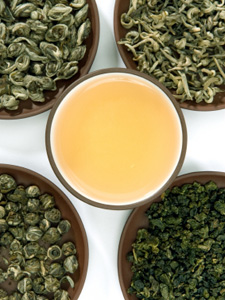Green Tea


Green tea is often lauded for the many amazing health benefits that it touts. However, in Asia, the birthplace of tea, green tea is widely enjoyed not only for medicinal effects, but also for the many dimensions of flavor that can be experienced through the different varieties. In China, there are nearly as many varieties of green tea as there are towns.
In this lesson, we'll provide an in-depth look at the most popular of all varieties of tea worldwide - green tea. We'll discuss the growing regions, processing, taste and some interesting historical facts to provide a deeper knowledge of this delicious variety.
Green tea is produced primarily in China and Japan, where it is a celebrated beverage. Types of green tea vary significantly, depending on the steps taken during production, such as steaming, pan-firing, rolling, etc. However, it is the application of heat, either by steaming or pan-firing, which prevents the leaves from oxidizing and becoming oolong or black tea. Basically, green tea can be thought of as perfectly cooked vegetables: tender, fresh and full of bright green flavor. The more popular varieties of green tea include Dragonwell (also known as Lung Ching), Genmai Cha, Gyokuro, Gunpowder, Hojicha, Pi Lo Chun and Sencha, just to name a few.
In China, traditional hand-making methods are still employed in many places, particularly in the manufacture of the finest green teas. Mechanical driers and leaf rollers are used, too, but so are basic hot woks for firing, bamboo mats for withering, etc. In Japan, however, tea production has taken on a very different pursuit of cup perfection. They utilize precisely calibrated machine cutters to harvest the leaf, shearing only the newest, most tender growth from the top of perfectly manicured bushes. Japan is the only major producer to utilize machine harvesting in a way that still produces extremely high quality, expensive tea.
Basic steeping guidelines for green tea can be divided into two categories: steamed tea and pan-fired tea. Steamed green teas, particularly Japanese types, can become quite astringent if the water is too hot or the steep is too long. So, try either cooler water (170 or so) for 3 minutes, or hotter water (180 degrees) for 1 minute or less. Feel free to adjust to your taste, just keep in mind your main variables are always time and temperature.
Pan-fired green teas, such as the classic Dragonwell from China, can take a higher heat to bring out their gentle toasty notes. 180 degrees for 3-4 minutes is a good place to start. The general measuring ratio for green teas is one teaspoon per 8 oz cup of water. If the leaves are larger and lighter, you can use slightly heaping scoops.
With so many varieties and styles (and ways to steep them), you're sure to find a green tea that can easily be part of your healthy lifestyle, as well as daily sensory enjoyment. Reward your body and your taste buds!
 teaclass
teaclass
